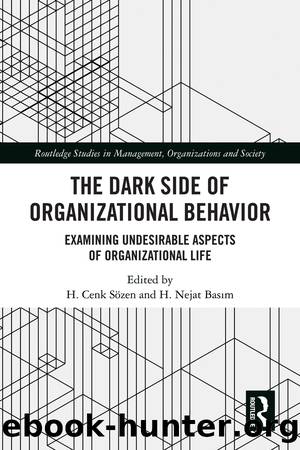The Dark Side of Organizational Behavior; Examining Undesirable Aspects of Organizational Life (for True Epub) by H. Cenk Sözen & H. Nejat Basım

Author:H. Cenk Sözen & H. Nejat Basım
Language: eng
Format: epub
Publisher: Routledge
Published: 2023-06-15T00:00:00+00:00
5
Toxic leadership
Korhan Arun
DOI: 10.4324/9781003292401-6
Introduction
Toxic leadership, a dark side of leadership, has recently been attracting more research interest in organizations. It is essential to study this aspect of leadership because, with the benefit of hindsight, organizations and leaders can learn from the toxic treatment, whether toxic behavior of a leader may serve as an impetus or a constraint for positive or negative personal and organizational transformation. This kind of leadership has been discussed in the literature but not clearly defined (Labrague et al., 2020). This chapter will present the theoretical context of toxic leadership focusing on toxic leadership characteristics, factors, and behaviors. As this kind of leader affects the loyalty, productivity, motivation, health and well-being of employees, the subordinate or follower perceptions as to whether their leader is considered toxic or not will also be addressed. Additionally, since leader toxicity presents both challenges and opportunities for organizational development, these two positive and negative aspects also will be emphasized. For this purpose, general phenomenological definitions of the term are explained first then, how toxic leadership relates to the context in which it appears is connected.
The dark side of leadership, namely destructive or toxic leadership, became a topic of studies in the 1950s in the USA (Krumov et al., 2016). House and Howell (1992) first mentioned evil or immoral leadership under charisma. However, toxic leadership was first coined by Dr. Marcia Lynn Whicker (1996) and mentioned in the military by Reed (2015). Despite being a decades-old concept, mentioned earlier, toxic leadership has not been methodically studied (Singh et al., 2017). Toxic leadership is a separate area of leadership research not addressed in the existing leadership theory literature (Leet, 2011).
This kind of leadership falls under the trait theory. Trait theory evolved from the great man theory in the 1930s with the driving research of leader characteristics that are unusual from non-leaders and ineffective leaders. There is no specific definition of toxic leadership (Arun et al., 2017). Negative characteristics of the leaders can be also toxic (Walker et al., 2020). Toxic derives from Greek mythology; toxicus means âpoisonâ (Singh et al., 2017) that count as toxic, leadersâ behaviors are harmful or lethal to an organism. This definition identifies toxic leaders not only by their dysfunctional and negative behavior but also by the extent of the harm they inflict on others and the organization.
Additionally, there is a gradation of toxicity from careless and minor to intentional and seriously toxic (Reed, 2015). According to Lipman-Blumen (2005), purposefully behaviors of the leaders calculatedly harm others or enhance themselves at otherâs expense and unintentionally are called toxic leader behaviors. They âcause serious harm by apathetic and reckless behavior, as well as by their incompetenceâ (Krasikova et al., 2013). Padilla et al. (2007) defined toxic leadership depending on negative outcomes.
The dark side of leadership is a subcategory of bad leadership, and other subcategories of dark side of leadership are toxic leadership, derailed leadership behaviors, evil, destructive and abusive actions (Higgs, 2009). Bad leadership is the power of influence over followers
Download
This site does not store any files on its server. We only index and link to content provided by other sites. Please contact the content providers to delete copyright contents if any and email us, we'll remove relevant links or contents immediately.
The Brazilian Economy since the Great Financial Crisis of 20072008 by Philip Arestis Carolina Troncoso Baltar & Daniela Magalhães Prates(104795)
International Integration of the Brazilian Economy by Elias C. Grivoyannis(74586)
The Art of Coaching by Elena Aguilar(52175)
Flexible Working by Dale Gemma;(23210)
How to Stop Living Paycheck to Paycheck by Avery Breyer(19562)
The Acquirer's Multiple: How the Billionaire Contrarians of Deep Value Beat the Market by Tobias Carlisle(12104)
Thinking, Fast and Slow by Kahneman Daniel(11781)
The Radium Girls by Kate Moore(11616)
The Art of Thinking Clearly by Rolf Dobelli(9909)
Hit Refresh by Satya Nadella(8851)
The Compound Effect by Darren Hardy(8504)
Atomic Habits: Tiny Changes, Remarkable Results by James Clear(8043)
Tools of Titans by Timothy Ferriss(7807)
Turbulence by E. J. Noyes(7697)
Change Your Questions, Change Your Life by Marilee Adams(7371)
A Court of Wings and Ruin by Sarah J. Maas(7250)
Nudge - Improving Decisions about Health, Wealth, and Happiness by Thaler Sunstein(7239)
How to Be a Bawse: A Guide to Conquering Life by Lilly Singh(7154)
Win Bigly by Scott Adams(6825)
